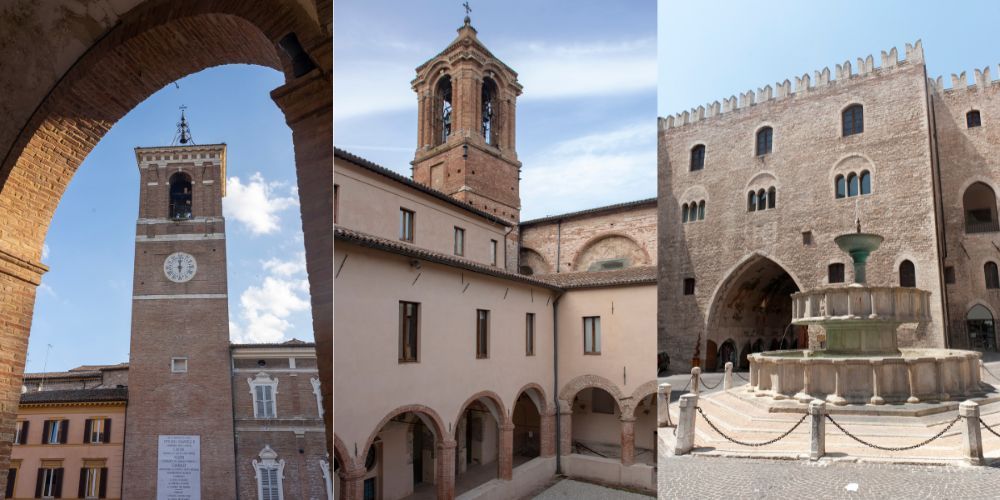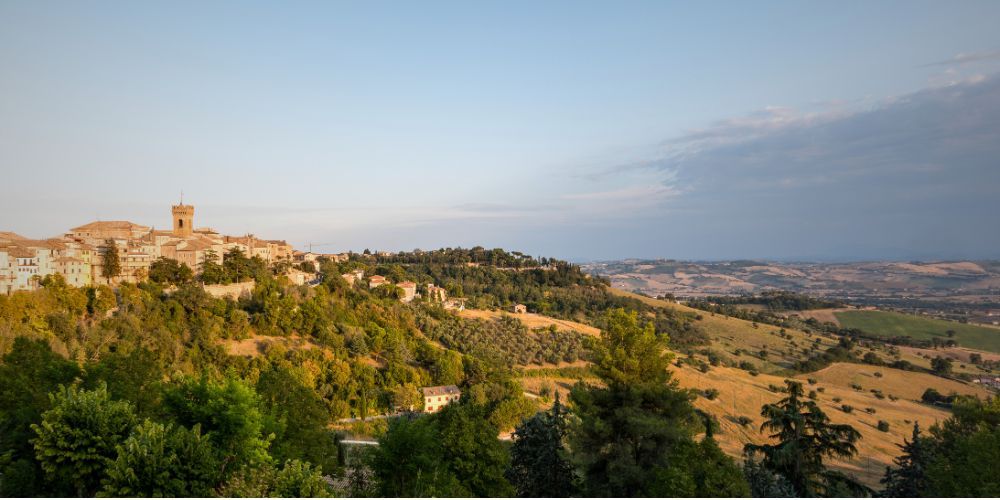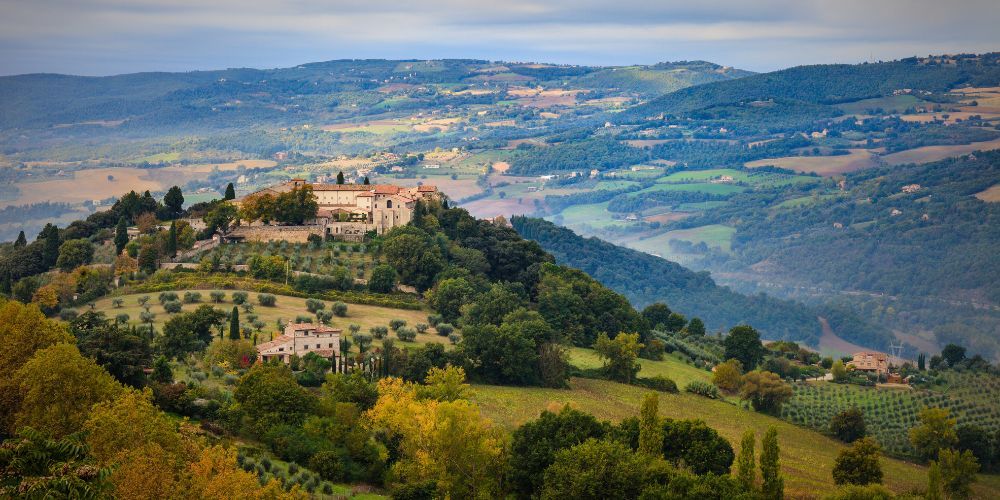One of the most exceptional wonders of Italy is the ability of its villages, from North to South including islands, to preserve for centuries arts, crafts and monumental beauties enclosed in real landscape jewels to be discovered. Today we want to accompany you to one of these places on your next adventure in Le Marche: destination Fabriano, the historic town of paper - handmade, of course!
In this article we will visit together the village of Fabriano and discover the most beautiful things to see you can’t miss in the town for a truly complete travel experience. But that's not all: we recommend you to read until the end, we have reserved some interesting surprises for you to better plan your itineraries discovering Le Marche and nearby Umbria! If everything is ok, buckle up and let’s get started now!
(Original cover picture, here; Source: Wikipedia; Author: Victortorresan)

Where is Fabriano and how to get there

Before visiting Fabriano and discovering the things to see in the town of paper, of course we must first get there. It is located in the hinterland of Marche (psst, take a look here!), in the province of Ancona, in the heart of the country and not far from the regional border with Umbria. In this area, Fabriano stands out for its unique landscape in full harmony with the surrounding nature, where the work of human and its architecture fits in with the beauty of the green spaces of the area, rich in parks and nature reserves, such as those of the Mounts San Vicino, Canfaito and Cucco, Gola della Rossa and Bosco di Frassasi (find out more here).
Let's find out how to get to Fabriano. First, starting from Ancona: you can reach the town of paper comfortably by train traveling on both regional and intercity trains (in particular towards Rome). Alternatively, if you prefer to travel by car you need to reach Falconara Marittima on SS16 and then continue inland on SS76 up to your destination; the same route is also valid starting from other cities, such as Pescara from the South or Pesaro and Rimini from the North: you will need to reach Ancona along SS16 and then continue as just described.
Instead, starting from Perugia the car journey involves reaching the Umbria’s airport entitled to S. Francis of Assisi to the West of the city, then driving on SS318 and SS76 crossing the regional border up to your destination; you can travel by train too, but less comfortably, traveling on regional trains first to Foligno and then to Fabriano.
Things to see in Fabriano: its historic centre, Piazza del Comune
Here we are finally in Fabriano, the splendid town of paper in the heart of Marche region. Let's not waste time and let's go straight to find out the things to see in this fantastic gem!
Where should we start from if not the heart of the historic centre of Fabriano? We are in Piazza del Comune, or Platea Magna, an enchanting place that gives visitors the vivid sensation of traveling back in time to a remote era, between the Middle Ages and the Renaissance. In fact, it is exactly in the perimeter of this unusual triangular-shaped square that the political and administrative history of the village has been written for centuries, as evidenced by the wonderful architecture that characterizes the uniqueness of this place which today are important tourist attractions.
One of the symbols of Piazza del Comune and Fabriano is the Sturinalto, a stupendous stone and bronze fountain dating back to 1285 which occupies the center of the square; commissioned by the town’s council to represent the prestige of the village, this work is certainly inspired by the Fontana Maggiore of Perugia, built a few years earlier. But the true icon of the town is Palazzo del Podestà, located on the Northernmost side of the square and inaugurated in 1255: one of the most fascinating examples of Gothic architecture that has always been the seat of power in the town of paper.
On the opposite side of Piazza del Comune, towards South, we find the Bishop's Palace. Built in the mid 1500s by incorporating the pre-existing medieval civic tower, this majestic structure was originally the seat of the Priors. From 1729 the palace was entrusted to the control of the church, becoming the seat of the town bishops; this also led to its interesting aesthetic evolution with the introduction of the arched portico which today characterizes its front facade.
Speaking of porticoes, right away afterwards it is worth taking a walk through Loggiato S. Francesco, a portico with 19 arches dating back to 1600s which runs along the Eastern side of Piazza del Comune up to the historic Palazzo Chiavelli, house of one of the most important lordships of Fabriano. From its internal courtyard the magic continues, reaching what we could define as a small but exceptional hidden gem to discover within a larger one: the wonderful Teatro Gentile!
Near Piazza del Comune there is another truly interesting attraction in Fabriano: it is the Molajoli Civic Art Gallery, not far from the Cathedral of S. Venanzio which we will cover later.
Reaching the art gallery is very simple, you just need to walk along the road that opens between Palazzo dei Podestà and Bishop's Palace until you reach the adjacent small square dedicated to Pope John Paul II: you will immediately recognize your destination, housed today inside the former hospital of S. Maria del Buon Gesù characterized by its reddish walls and its entrance portico with arches.
The artistic collection includes many valuable works of art dating back starting from the Middle Ages, with religious and non-religious themes, in particular canvases, frescoes, wooden sculptures and tapestries. If you love art indiscriminately and look for a truly satisfying experience, you really must visit Fabriano and its art gallery!
These attractions in the historic center of Fabriano are magnificent, you agree? But our visit continues, the journey doesn't end here. Keep on reading and discover with us more things to see in the spectacular town of paper - in fact, we're heading to the very place where this product is celebrated as it deserves!
Things to see in Fabriano: Paper and Watermark Museum
And here we are, in the place where the most authentic story of Fabriano is told: we finally came to the Paper and Watermark Museum. It is a fantastic gallery, organized in a suggestive setting inside a former convent, where the history, tradition, culture and resourcefulness of a city rediscover everyday their origins in the art of handmade paper processing.
Inside the museum it is possible to visit truly characteristic environments which faithfully reproduce the ancient laboratories for the production of handmade paper, admiring the manufacturing process, the machinery, the tools and also a collection of watermarks produced in Fabriano, a city which thanks to its production had received the title of Unesco Creative City in 2013. The museum also has an internal bookshop, where visitors (thousands every year) can purchase products made by master paper makers.
After visiting the museum dedicated to handmade paper, a few steps away from here we suggest to spend some time relaxing in the green tranquility of Regina Margherita Park. This great little natural corner is itself an attraction to discover for tourists visiting Fabriano, especially in spring and summer; and with its green trees, its avenues and its pond with bridge, we like to describe it with eyes in awe like a small miniature of the newyorkese Central Park set in a wonderful Italian village!
Do you want to visit other museums in Fabriano? Don't worry, the town of paper offers many interesting ideas to stimulate the curiosity of all visitors! Among these: the diocesan museum, the museum of the historical piano and sound, the archaeological museum dedicated to the Picenes and the Celts, the nativity scene museum and the Ruggeri-Manucci art gallery.
Things to see in Fabriano: the Cathedral
Any more things to see in the town of paper? We return to the heart of the historic center of Fabriano to visit the beautiful Cathedral of S. Venanzio, the main sacred place in the village. The building stands proudly on Piazza Giovanni Paolo II (in front of the Art Gallery), characterized by its reddish facade, like many other historic buildings here in Fabriano.
The first evidence of the existence of this church dates back to 1047, but its construction and consecration as we know it today dates back only to 1663. The dominant architectural style is in fact Baroque, typical of the 1600s, but there is no shortage of elements characteristic of other artistic styles such as Gothic, in particular the apse and some internal decorations.
The Cathedral preserves many works of sacred art, especially frescoes by the local artist Allegretto Nuzi who lived in the Middle Ages. The famous Marquis Onofrio del Grillo is also buried inside, a prominent historical figure from Fabriano.
In the city there are, of course, many other churches and sacred places to visit and admire, above all for their great artistic value capable of attracting the attention of tourists who are more sensitive to the charm of beauty in architecture and arts.
In particular, we suggest you visit Oratorio del Gonfalone, halfway between the historic center and the Paper and Watermark Museum: a magnificent structure of medieval origin, rebuilt and embellished several times between 1500s and 1600s, with a luxurious ceiling carved and decorated in pure gold and a cycle of canvases dedicated to the life of the Virgin Mary. Among the other churches we remember those dedicated to S. Benedetto, S. Domenico, SS. Biagio and Romualdo and S. Filippo.
If you want to venture into the surroundings of Fabriano and discover places with a unique charm, full of stories to tell, then we suggest you also visit the Hermitage of Valdisasso! Here we are really just a few steps away from the border with Umbria: it is an ancient structure framed in a landscape of refined natural beauty dominated by the greenery of the valleys around, a scenery that inspires calm and serenity just at the sight; it’s not surprising that this place, so peaceful and apparently much closer to the divine than cities, was where St. Francis of Assisi dwelled for several years.
Find out what to see and to do in Marche region after visiting Fabriano

Fabriano is a wonderful place waiting to be discovered. But even the most beautiful stories, unfortunately, come to an end. Our visit to the town of handmade paper and its surroundings is over, but...who said the journey ends here?
Le Marche still has much, much more to offer; and one of its most shining jewels is certainly Recanati, the birthplace of the legendary poet of the Infinito, Giacomo Leopardi. Do you want to enjoy the best visit of this beautiful town with us? Find out more by clicking the button below!
Visit Recanati by exploring its best attractionsAs you travel up and down the Marche region we strongly recommend you savor the delicious regional cuisine, rich in flavors and traditions that satisfy even the finest palates. Following, here are some suggestive ideas for you to best organize your travel itinerary in this wonderful region:
- visit Fermo, a wonderful timeless jewel in a beautiful natural setting that embraces a warm and pleasant hinterland with a romantic view of the sea that stands out in the distance;
- discover the Monte Conero Riviera, a land of wild nature and beautiful beaches just South of Ancona;
- have fun at the enchanting and joyful Carnival of the town of Fano, where the sea is happy even in winter;
- explore the wonders of the historic center of Urbino, a rare gem registered in the Unesco heritage.
Travel itinerary between Le Marche and Umbria through Fabriano

What could be better than concluding our travel itinerary by stopping in nearby Umbria, perhaps passing through Fabriano once again? In particular, the most beautiful stage that we can recommend is Assisi, an iconic location that has always been associated with the name of S. Francis.
The figure of the Saint played a very important role in the cultural evolution of this vast territory, so much that he is considered now as the national Patron Saint of the entire Peninsula; and it is absolutely no coincidence that in Assisi, as well as in Fabriano and in many, many other villages throughout Central Italy, Francis is a key figure and symbol of peace, brotherhood and dialogue between peoples, fundamental traits of his human mindset, even before than religious.
If you also want to visit and experience the places of S. Francis for a profound and immersive travel experience, take a look below!
Visit the places of S. Francis in AssisiAbout the author
Written on 11/11/2023






Massimiliano Antonio Primi
Get ready for a trip to Fabriano, the evocative town of paper in the heart of Italy. Discover with us the things to see in this gem of the Marche!